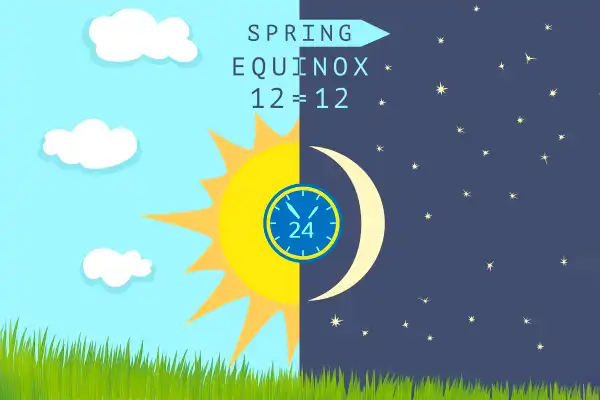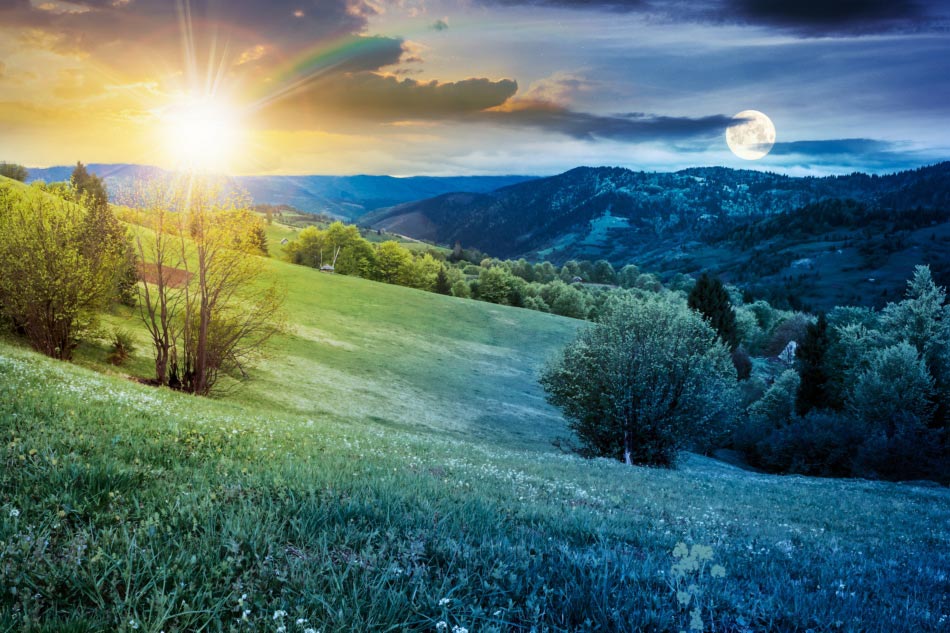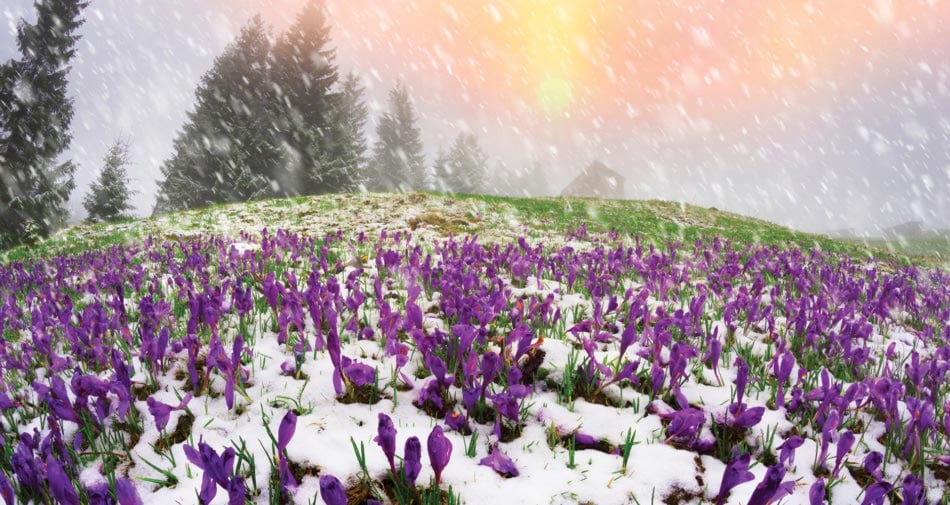When Is The First Day of Spring 2026?
The first day of spring 2026 is on Friday, March 20, 2026, at 10:46 a.m. EDT. For those of us in the Northern Hemisphere, this is marked by the arrival of the spring equinox (otherwise known as the “First Point of Aries”).
Traditionally, we celebrate the first day of spring on March 21, but astronomers and calendar manufacturers alike now say that the spring season starts on March 20 in all time zones in North America. Yet spring equinox marks the official start of the spring season. Fun fact: In 2024, spring fell on March 19—the earliest first day of spring in 128 years!
How long will winter hold on and when will weather warm up? Our Members have access to 12 months of forecasts.
What Does Spring Equinox Mean?
Vernal translates to “new” and “fresh,” and equinox derived from the Latin aequus (equal) and nox (night).

So what does that mean? Essentially, our hours of daylight—the period of time each day between sunrise and sunset—have been growing slightly longer each day since the winter solstice in December, which is the shortest day of the year (at least in terms of light).
Even though we know that after December 21st, the days start getting steadily longer, we still see more darkness than light over the course of a day in those three months leading up to spring. The vernal equinox marks the turning point when daylight begins to win out over darkness.
At this moment, the direct rays of the Sun are shining down on the equator producing the effect of equal day and night (give or take a few minutes, see below). After the vernal equinox, the direct rays of the Sun migrate north of the Equator (with hours of daylight steadily growing longer) until they finally arrive at the Tropic of the Cancer (latitude 23.5 degrees north).
The migration of the Sun’s direct rays comes to a halt on that day; this is as far north as they will go. We call this the summer solstice (solstice is a suspension of the migration of the Sun’s direct rays). It is the longest day of the year in terms of hours of daylight.
After the summer solstice, the direct rays proceed to head south and the days begin to grow shorter. It will take another three months, until the autumnal equinox for the periods of daylight and darkness to reach equilibrium once again.
The rays ultimately reach the Tropic of Capricorn (latitude 23.5 degrees south) on the day of the winter solstice and the whole cycle begins again!
Length of Day Vs. Night

A question revolving around the spring equinox concerns the length of day versus night. We have been taught that on the first days of spring and autumn, the day and night are equal to exactly 12 hours all over the world.
Yet, if you check the calendar pages in our Almanac, you will find that this is not so. In fact, our tables tell you that on the days of the spring and fall equinox, the length of daylight is actually longer than darkness by several minutes.
The reason this happens can be attributed to our atmosphere. If Earth was a planet that did not have an atmosphere, then yes, on the equinox days the length of the day and night would be exactly even.
However, our atmosphere acts like a lens and refracts (bends) its light above the edge of the horizon. Put in another way, when you watch the Sun either coming up above the horizon at sunrise, or going down below the horizon at sunset, you are looking at an illusion — the Sun is not really there, but already below the horizon.
As a result, we actually end up seeing the Sun for a few minutes before its disc actually rises and for a few minutes after it has actually set. Thus, thanks to atmospheric refraction, the length of daylight on any given day is increased by approximately six or seven minutes.
Why Does the First Day of Spring Change?
There are a few reasons why seasonal dates can vary from year to year:
- A year is not an even number of days and neither are the seasons.
- Leap year days may factor in.
- Earth’s elliptical orbit is changing its orientation (skew), which causes the its axis to constantly point in a different direction, called precession (via NASA).
Since the seasons are defined as beginning at strict 90-degree intervals, these positional changes affect the time the earth reaches each 90-degree location in its orbit around the sun.
Second, the pull of gravity from the other planets also affects the location of Earth in its orbit.

Is Spring Getting Shorter?
The current seasonal lengths for the Northern Hemisphere are (approximately):
- Summer — 93.641 days
- Autumn — 89.834 days
- Winter — 88.994 days
- Spring — 92.771 days
As you can see, the warm seasons, spring and summer, combined are 7.584 days longer than the colder seasons, fall and winter (good news for warm weather lovers!).
However, spring is currently being reduced by approximately one minute per year and winter by about one-half a minute per year. Summer is gaining the minute lost from spring, and autumn is gaining the half a minute lost from winter.
Winter is the shortest astronomical season, and with its seasonal duration continuing to decrease, it is expected to attain its minimum value—88.71 days—by about the year 3500.
Why The Changes?
So why, you might ask, are the “warm seasons” (spring and summer), longer than the “cold seasons” (autumn and winter)?
It goes back to Earth’s elliptical orbit again, as mentioned above. We are 3.1 million miles closer to the Sun (called perihelion) in early January, as compared to early July, when we are farthest (called aphelion). And the closer a celestial body is to the Sun, the faster it must move in its orbit—gravity insists upon that, that’s a fundamental, natural law that was demonstrated 400 years ago by the astronomer, Johann Kepler. That means during cold months, when we are closest to the Sun, we are sweeping fastest through our orbit in space. In July, when we’re farther from the Sun, we’re moving more slowly.


Gostei do seu poste, existe muitos artigos em seu blog relacionado a este que acebei de ler gostei de seu blog.
Muito obrigado!
March 20, 2026. You wrote 2025.
Why is it hotter in July? We are farther from the Sun. Why is it cold in January? We are closest to the sun.
The northern hemisphere is tilted up to 23.5 degrees toward the sun in late June and tilted away from the sun in late December. During Spring and Fall Equinox the earth is not tilted.
Let me put it another way; since this is more about time than distance, heat and light. Whether standing on the equator or on either pole; Earth’s full rotation takes 24 hours. The equatorial circumferential “spin” will cover many thousands of miles while the exact point of the poles will cover no distance at all; yet the same 24 hour period has elapsed.
… disapproval? Seriously? The poles are always increasing or decreasing in circumferential path in relation to the hub or axis of it’s orbit…the sun; hence the gradual increase or decrease in light and heat. The earth, as a whole, is not getting closer or further from the sun or speeding or slowing it’s orbit around the sun or it’s own rotation. And by the year “3500”…riddle me this y’all…how many of you are going to live another 1500 years and how are you going to change the naturally occurring process…for what and perhaps millions of years?
…from Autumn equinox to Spring equinox, when the northern hemisphere and pole begin a shorter circumferential path; giving the appearance of velocity change with subsequent elongation of day “light” and heat.
If I may, the Earth’s orbit is exactly the same and has not changed. The “tilt” is what makes the north and south poles, respectively, spin or orbit the sun “faster” or “slower” than the equatorial line; which always, always, remains the same distance from the sun. It’s an illusion that seems to have eluded most if not all. The earth spins on its axis 1 rotation every day; but it takes 365 days for 1 solar orbit. The sun doesn’t move and the Earth’s “tilt” doesn’t change. The axle or hub on a bicycle tire; based solely on it’s circumference will take many more revolutions to cover the same distance as the tire with it’s much larger circumference. The appearance is illusory as the same point on the tire matches the same point on the axle without variance. So it is in the “winter” months in the northern hemisphere. The orbit of a given point, the “pole” being “tilted” away from the sun, has a larger circumferential path in relation to the axis of the orbit…the sun.
If the “equatorial line – remains the same distance from the sun” the orbit would be circular. It is not.
Regarding day lengths, “True”sunrise, as well as “True” sunset is when the solar disc is exactly half way above/below the horizon; which is about 4 minutes different on each side of the day, thus 8 minutes longer than 12 hours,on the equinoxes!!! That is the REAL reason that daylight on the equinoxes is longer than 12 hours!!!
But the distance to the Sun in winter and summer are reversed in the Southern Hemisphere. So for their winter they are closer to the Sun.
Wait a minute–it says in winter we are closer to the sun, which is a source of heat. Are you sure you got that right?
The earth as a whole is slightly closer to the sun, yet the Northern Hemisphere is tilted away from the sun in winter, hence why it’s colder in the winter. At this point in time, we have short, mild winters and long, mild summers, but due to the precession of the axis of rotation over tens of milennia, there are periods when the Northern Hemisphere faces away from the sun when the earth is farthest from the sun. This leads to longer, colder winters and shorter, hotter summers, often coinciding with ice ages.
He IS mistaken (backwards)
What it means is that the winter and summer seasons are more extreme in the southern hemisphere than they are in the northern hemisphere!